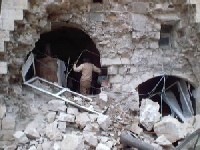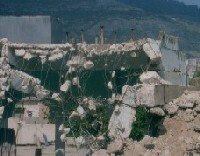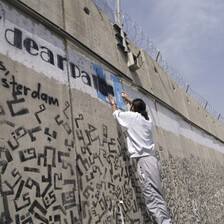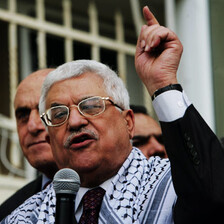
Ghadir Shaka’a
‘The new barbarism of the 21st century has looted through thirty centuries of civilization’, writes Ghadir, my cousin. This week she returned to Nablus, after having been confined to her apartment in Ramallah for the past month, as Israeli soldiers and tanks occupied the city.
‘History has been destroyed, lives were broken, wounded civilians executed, the safe homes of ordinary citizens became their graves. Ambulances and medical personnel have been shot at, the sick were prevented access to medical care. They were killed in significant numbers. Newborn children died. Those who attempted to defend in vain and with simple arms the honour of the city were killed. Every corner or street in the city tells a story of 21st century barbarism.’
‘Physicians tell you that they were prevented by force to hand over the sick and wounded. Mothers will tell you about the fear of their children. Young mothers will tell you about the death of their newborn babies in front of their eyes, as they were unable to go to hospital. Residents of the old city of Nablus will tell you how their history was destroyed on top of their heads. They will tell you how detainees, who were blindfolded with their hands tied behind their backs, were shot at close range. Those who were lucky enough to escape death have been forced on foot to Huwara detention center.’
‘Those who suffered the least will tell you how hundreds of residents, after being confined in their homes, forced to live under house arrest, managed to survive without electricity and running water for more than a week. They will tell you how Israeli soldiers came to their neighborhoods, well after midnight. How trigger-happy soldiers forced a doctor out of his home. How they put him in a tank and took him away to another neighborhood as a human shield to knock on the doors of civilian homes, under the cover of darkness, where children were asleep. He watched how people were gathered, detained, tied up and blindfolded before reserve and regular Israeli soldiers blew up the entrances of their homes.’
‘Many can tell you how they have been used as human shields. Some for a few hours, others for days. Later they were returned to their families, who had been waiting for them, afraid of receiving a dead body instead.’
‘In Najah street, more than ten families, women and children, were kept in the hospital, opposite the appartment building in which they normally live. They were forced to stay there until all men between 14 and 50 were arrested. They were told that weapons were found in the building and that the soldiers were going to blow up the entire building. The families were in disbelief. They had seen soldiers carrying wires for the explosives before even searching the building. After midnight, they heard a loud explosion. It was not until the next morning that they knew that only one appartment was blown up. Of course, the entire building was affected and damaged.’
‘The International Committee of the Red Cross was not allowed to intervene. Families were not allowed to go to their homes. Also relatives or neighbors were not allowed to go to the building. They took the risk and crossed the street, walking to their homes afraid that a sniper would shoot them.’

Ghadir Shaka’a
‘In the eyes of Israeli soldiers, it was not enough that the Assali family suffered to watch their father die after a heart attack in their home in the old city. It was not enough that the family suffered because they had to keep his dead body in a room in their home. An Israeli sniper shot and killed Naser Assali in his home. The bullet entered in his heart two days after his father’s death. The family had to keep his dead body with his father’s for another three days, until they managed to bury them.’
‘Four schools in Nablus were badly damaged. The schools are not used for education. Students who normally attend these schools are given afternoon classes in other schools. The Fatimiya school is an historic building. It was built during the Ottoman period. It is now destroyed. There has been systematic destruction of clinics, offices, shops, and factories. It is beyond any doubt that the Israeli soldiers meant to hurt the people as hard as possible, to make it impossible to carry on with their lives. It needs an historian to tell you about the destruction of our heritage. Old allies, homes, roads, and yards were turned upside down. Homes, mostly belonging to the less fortune people were destroyed.’
‘The Israeli army moved from house to house through walls. Residents became refugees in their own town. They were led to schools outside the old city. F16 fighter jets and tanks shelled unmercifully the old city. Residents who chose not to become refugees stayed in their homes. Four ancient soap factories were shelled, the heritage of Nabulsi, Kan’an, Masri and Rantisi destroyed. Two of the factories simply vanished from the earth. These factories are the history of Nablus. They have been the main source of economy throughout centuries.’

Ala Abu Dheer
‘For a whole week, six hospitals in Nablus failed to report receiving a single wounded. When injured persons arrived, there were only a few. Some of the wounded had horrific multiple injuries. The Israeli soldiers came to kill and destroy.’
‘The makeshift hospital, hosted by al-Beik mosque inside the old city, was poorly equipped. No help was allowed in. Medical personnel dealt with serious injuries with understandable, miserable results. Some of the lives would have been saved if they were treated in proper hospitals in the city. The medical personnel who stayed there shared their dormitory with dead bodies. Eventually, the people of Nablus, in this 21st century, had to bury their martyrs in a mass grave in the old city.’
‘When soldiers entered the homes of the families of martyrs, they would spit on the pictures of the martyrs. Some pictures were burnt and some soldiers wiped their shoes on them. The pain and the grief of these families was enough for these soldiers. They just wanted to add more pain, grief, anger and to humiliate them. Why would they expect less from these racists, who are filled with hatred and a history of bloodshed, who have built and expanded their state through massacres against Palestinians.’
‘Most of those who were killed in Nablus were civilians. The grandmother of the Shu’bi family was recovered from the ruins of their home. Among the seven family members, only she survived. She lost her husband, her son and his wife, who was pregnant, her daughter, and her grandchildren. The grandmother said she kept hearing her two grandchildren moaning for two days before they died.’
‘Poorly equipped armed Palestinians stood bravely in an attempt to defend their city, their heritage and their people. They were killed and others were forced to surrender in the face of heavy weaponry and taken to unknown destinations. Those who were most lucky escaped and fled outside the old city. They will tell you that they did not see any Israeli soldiers on foot. The Israeli army either shelled from tanks or planes.’
‘The 78 martyrs in Nablus were kept in a refrigerated truck belonging to al-Safa milk factory. They were not allowed to be buried until two days before the Israeli soldiers left the city center. They were buried in mass graves. No funeral was allowed. All families of martyrs received condolences at the same spot. Berieved mothers, sisters, wives, daughters stuck a badge with the name of their beloved ones. Some of them stuck more than a badge. Members of the Shu’bi family wore six badges.’
‘When residents finally went outside and walked in their streets, they saw their city in ruins, their businesses looted, offices turned into rubble, electricity and phone lines cut, water networks destroyed. The broken sewage system and piles of garbage added to the misery.’
‘Residents of Nablus, after being locked up in their homes for seventeen days, poured out to the dusty and ruined streets, filled with damaged or destroyed cars, broken street and traffic lights. They cried when they saw the destruction. They cried out their helplessness of the ruined history of their city. They are witnesses of hatred and 21st century barbarism.’
‘Residents of Nablus are slowly licking their wounds. It will take a long time before life turns to normal. Grief and anger is left.’





